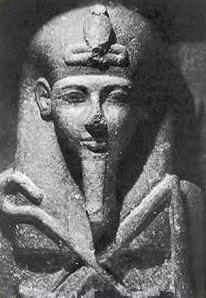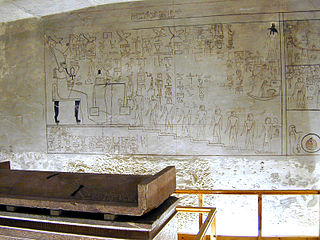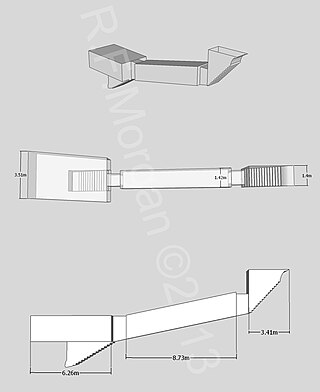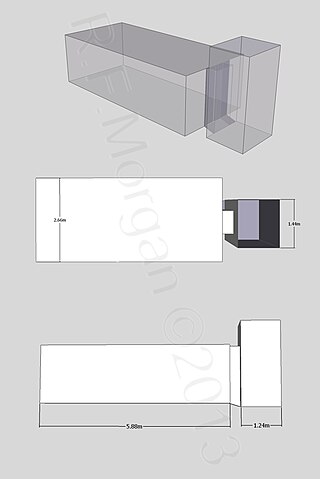
KV55 is a tomb in the Valley of the Kings in Egypt. It was discovered by Edward R. Ayrton in 1907 while he was working in the Valley for Theodore M. Davis. It has long been speculated, as well as much disputed, that the body found in this tomb was that of the famous king, Akhenaten, who moved the capital to Akhetaten. The results of genetic and other scientific tests published in February 2010 have confirmed that the person buried there was both the son of Amenhotep III and the father of Tutankhamun. Furthermore, the study established that the age of this person at the time of his death was consistent with that of Akhenaten, thereby making it almost certain that it is Akhenaten's body. However, a growing body of work soon began to appear to dispute the assessment of the age of the mummy and the identification of KV55 as Akhenaten.

Seti II was the fifth pharaoh of the Nineteenth Dynasty of Egypt and reigned from c. 1203 BC to 1197 BC. His throne name, Userkheperure Setepenre, means "Powerful are the manifestations of Re, the chosen one of Re." He was the son of Merneptah and Isetnofret II and sat on the throne during a period known for dynastic intrigue and short reigns, and his rule was no different. Seti II had to deal with many serious plots, most significantly the accession of a rival king named Amenmesse, possibly a half brother, who seized control over Thebes and Nubia in Upper Egypt during his second to fourth regnal years.

Twosret, also spelled Tawosret or Tausret was the last known ruler and the final pharaoh of the Nineteenth Dynasty of Egypt.

Tomb KV46 in the Valley of the Kings is the tomb of the ancient Egyptian noble Yuya and his wife Thuya, the parents of Queen Tiye and Anen. It was discovered in February 1905 by Chief Inspector of Antiquities James E. Quibell, excavating under the sponsorship of American millionaire Theodore M. Davis. Despite robberies in antiquity, the undecorated tomb preserved a great deal of its original contents including chests, beds, chairs, a chariot, and numerous storage jars. Additionally, the riffled but undamaged mummies of Yuya and Thuya were found within their disturbed coffin sets. Prior to the discovery of the tomb of Tutankhamun, this was considered to be one of the greatest discoveries in Egyptology.

Tomb KV19, located in a side branch of Egypt's Valley of the Kings, was intended as the burial place of Prince Ramesses Sethherkhepshef, better known as Pharaoh Ramesses VIII, but was later used for the burial of Prince Mentuherkhepshef instead, the son of Ramesses IX, who predeceased his father. Though incomplete and used "as is," the decoration is considered to be of the highest quality.

Akhenre Setepenre Siptah or Merenptah Siptah was the penultimate ruler of the Nineteenth Dynasty of Egypt. His father's identity is currently unknown. Both Seti II and Amenmesse have been suggested although the fact that Siptah later changed his royal name or nomen to Merneptah Siptah after his Year 2 suggests rather that his father was Merneptah. If correct, this would make Siptah and Seti II half-brothers since both of them were sons of Merneptah.

The area of the Valley of the Kings, in Luxor, Egypt, has been a major area of modern Egyptological exploration for the last two centuries. Before this, the area was a site for tourism in antiquity. This area illustrates the changes in the study of ancient Egypt. Starting as antiquity hunting, and ending as scientific excavation of the whole Theban Necropolis. Despite the exploration and investigation noted below, only eleven of the tombs have actually been completely recorded.

Tomb KV48 is an ancient Egyptian tomb located in the Valley of the Kings in Egypt. It was discovered in 1906 by Edward R. Ayrton excavating on behalf of Theodore M. Davis, and contained the robbed burial of the Eighteenth Dynasty noble Amenemipet called Pairy.

Tomb KV15, located in the Valley of the Kings in Egypt, was used for the burial of Pharaoh Seti II of the Nineteenth Dynasty. The tomb was dug into the base of a near-vertical cliff face at the head of a wadi running southwest from the main part of the Valley of the Kings. It runs along a northwest-to-southeast axis, comprising a short entry corridor followed by three corridor segments, which terminate in a well room that lacks a well, which was never dug. This then connects with a four-pillared hall and another stretch of corridor that was converted into a burial chamber.

Tomb KV47, located in the Valley of the Kings in Egypt, was used for the burial of Pharaoh Siptah of the Nineteenth Dynasty. It was discovered on December 18, 1905 by Edward R. Ayrton, excavating on behalf of Theodore M. Davis; Siptah's mummy had been found earlier, cached in KV35. It was the last of the Nineteenth and Twentieth Dynasty kings tombs to be uncovered in the Valley. Ayrton stopped his excavation in 1907 due to safety fears, and Harry Burton returned in 1912 to dig further. The cutting of a side passage was halted after the workmen cut into Side Chamber Ja of the tomb of Tia'a (KV32). The tomb was unfinished at the time of its use.

Tomb KV57 is the royal tomb of Horemheb, the last pharaoh of the Eighteenth Dynasty and is located in the Valley of the Kings, Egypt.

Tomb KV49, located in the Valley of the Kings, in Egypt is a typical Eighteenth Dynasty corridor tomb. It was the first of a series of tombs discovered in 1906 by Edward R. Ayrton in the course of his excavations on behalf of Theodore M. Davis. The tomb was abandoned before it was completed, and the work was halted as the stairwell in the single chamber was being cut. It was probably used as a store for royal linen, or was used as a mummy-restoration area in the later New Kingdom.

Tomb KV58, known as the "Chariot Tomb", is located in the Valley of the Kings in Egypt. It was discovered in January 1909 by Harold Jones, excavating on behalf of Theodore M. Davis. The circumstances of the discovery and specifics of the excavation were only given a passing mention in Davis' account, who attributes the discovery to Edward Ayrton in 1907 instead. The tomb consists of a shaft leading to a single chamber and contained only embossed gold foil, furniture knobs, and a single ushabti. The contents likely originated from the Eighteenth Dynasty tomb of Ay in WV23. Davis considered this tomb to be the burial place of the then little-known pharaoh Tutankhamun.

Tomb KV50 is located in the Valley of the Kings, in Egypt. It was discovered in 1906 by Edward R. Ayrton excavating on behalf of Theodore M. Davis. Together with KV51 and KV52, it forms a group known as the "Animal Tombs". It contained the burial of a dog mummy and a mummified monkey and is probably associated with the nearby tomb of Amenhotep II (KV35).

Tomb KV51 is located in the Valley of the Kings, in Egypt. It was discovered in 1906 by Edward R. Ayrton excavating on behalf of Theodore M. Davis. The tomb, together with KV50 and KV52 forms a group of three known as the "Animal Tombs". It contained the burials of three monkeys, one baboon, one ibis and three ducks, and is probably associated with the nearby tomb of Amenhotep II (KV35).

Tomb KV52 is located in the Valley of the Kings, in Egypt. It was discovered in 1906 by Edward R. Ayrton excavating on behalf of Theodore M. Davis. Together with KV50 and KV51 it forms a group known as the "Animal Tombs", it contained a mummified monkey, and is probably associated with the nearby tomb of Amenhotep II (KV35).

Tomb KV53 is located in the Valley of the Kings, in Egypt. It was discovered in 1906 by Edward R. Ayrton excavating on behalf of Theodore M. Davis. It has been excavated but never been fully planned, and consists of a single chamber at the end of a shaft.

The Valley of the Kings, also known as the Valley of the Gates of the Kings, is a valley in Egypt where, for a period of nearly 500 years from the 16th to 11th century BC, rock-cut tombs were excavated for the pharaohs and powerful nobles of the New Kingdom.
Tiaa or Tiya or Tiy was thought to be the third wife of Pharaoh Seti II, after Takhat and Twosret. Fragments of her burial equipment were found in the tomb of Siptah (KV47), leading to the impression that she might have lived at the end of the 19th Dynasty. However, the king's tomb is connected to the burial of the 18th Dynasty queen Tiaa. The burial equipment of Tiaa mixed into the burial of Siptah. Recent research showed that all artifacts of a queen Tiaa belong to the 18th Dynasty queen. She is thought by some to have been Syrian (Ḫurru). She was once thought to be the mother of Rameses-Siptah, the next Pharaoh of Egypt after the death of his predecessor Seti II. However, Siptah's mother is now known to be a Canaanite woman named Sutailja or Shoteraja from a newly discovered relief in the Louvre museum.
The majority of the 65 numbered tombs in the Valley of the Kings can be considered minor tombs, either because at present they have yielded little information or because the results of their investigation was only poorly recorded by their explorers, while some have received very little attention or were only cursorily noted. Most of these tombs are small, often only consisting of a single burial chamber accessed by means of a shaft or a staircase with a corridor or a series of corridors leading to the chamber, but some are larger, multiple chambered tombs. These minor tombs served various purposes, some were intended for burials of lesser royalty or for private burials, some contained animal burials and others apparently never received a primary burial. In many cases these tombs also served secondary functions and later intrusive material has been found related to these secondary activities. While some of these tombs have been open since antiquity, the majority were discovered in the 19th and early 20th centuries during the height of exploration in the valley.





















